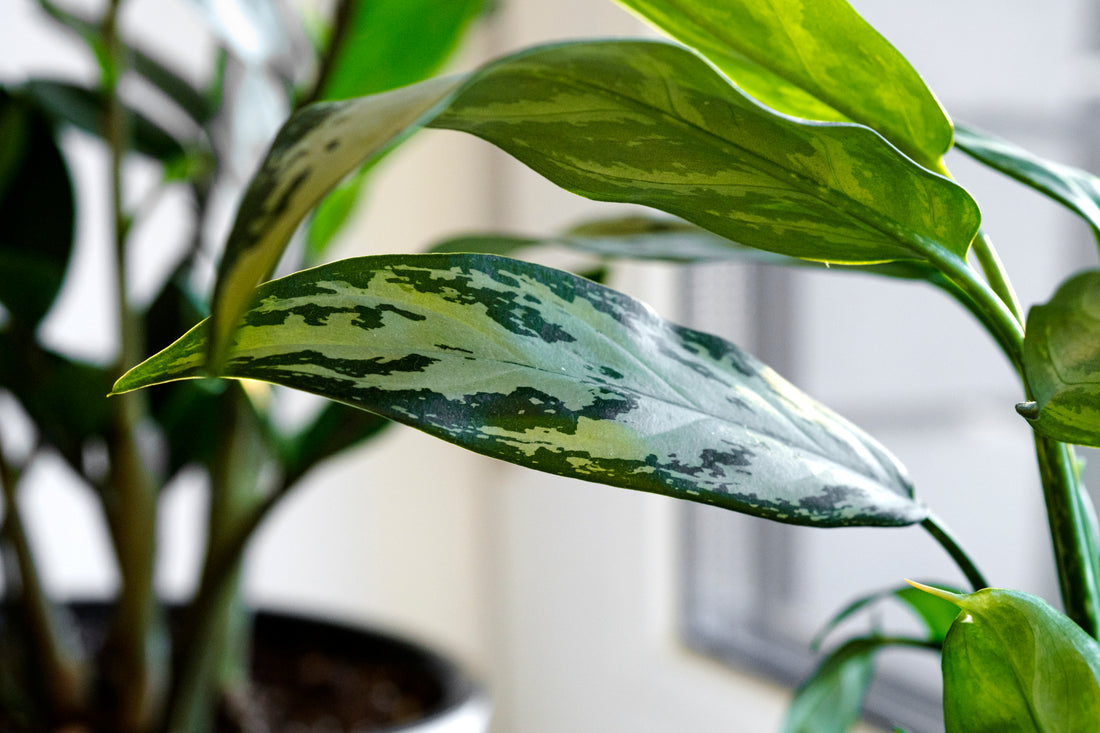Aglaonema Houseplant Care: Troubleshooting and Trendy Varieties
Aglaonema plants are a popular choice for plant enthusiasts due to their low maintenance needs and striking foliage. These tropical plants are native to Southeast Asia and come in a variety of colours and patterns, making them a trendy addition to any home decor. In this article, we will cover everything you need to know about aglaonema houseplant care, from basic care to troubleshooting common problems.
If you're new to aglaonema house plants, don't worry! We will start with the basics, including the ideal conditions for growing aglaonema, potting and repotting tips, and seasonal care. We will also discuss trendy varieties of aglaonema, including the popular 'Red Valentine' and 'Silver Queen' cultivars. Additionally, we will cover propagation methods so you can expand your aglaonema collection without breaking the bank.
Unfortunately, even the most well-cared-for plants can encounter problems. That's why we will also provide troubleshooting tips for common aglaonema issues, including yellowing leaves and pest infestations. Lastly, we will share pruning and grooming tips to keep your aglaonema looking its best. Whether you're a seasoned plant parent or just starting out, this guide has everything you need to know about aglaonema houseplant care.
Key Takeaways
- Aglaonema houseplants are a low-maintenance and trendy addition to any indoor space.
- Ideal growing conditions include medium to low light and well-draining soil.
- Troubleshooting common problems such as yellowing leaves and pest infestations is key to keeping your aglaonema healthy.

Aglaonema Houseplant Basics
Aglaonema is a popular houseplant that is known for its beautiful foliage and low maintenance requirements. These plants are native to Southeast Asia, and they are commonly known as Chinese evergreens. Aglaonema plants can be grown in a variety of light conditions, making them ideal for indoor spaces with low light levels.
Light Requirements
Aglaonema plants prefer bright, indirect light, but they can also tolerate low-light conditions. If you place your plant in a low-light area, the leaves may become darker in color. However, if you place your plant in direct sunlight, the leaves may become scorched and damaged. Therefore, it's important to find a balance between too much and too little light.
Watering
Aglaonema plants prefer to be kept evenly moist, but they can also tolerate periods of dryness. Overwatering can lead to root rot, so it's important to let the soil dry out slightly between waterings. A good rule of thumb is to water your aglaonema when the top inch of soil feels dry to the touch. When watering, make sure to water deeply until the water runs out of the drainage holes at the bottom of the pot. During the winter months, when the plant is not actively growing, you can reduce watering.
Temperature and Humidity
Aglaonema plants prefer warm temperatures between 18°C and 26°C. They can tolerate cooler temperatures, but they should not be exposed to temperatures below 16°C. These plants do not require high humidity levels, but they can benefit from occasional misting or placement near a humidifier. Avoid exposing your aglaonema to cold draughts or extreme temperatures.
Soil and Fertiliser
Aglaonema plants prefer well-draining soil that is rich in organic matter. When planting or repotting, use a high-quality potting mix, like our SOIL FRESHENER potting soil.
Spray the leaves of your aglaonema with our PLANT FOOD organic liquid fertiliser fortnightly between spring and autumn and monthly in winter, to encourage plant growth, strengthen its roots and increase plant resistance to diseases and abiotic stresses.
Feed the potting soil of your aglaonema with our SOIL BOOSTER organic fertiliser every two to three months. Rich in organic matter and nutritionally balanced, this product contains plants' main macro and micronutrients.
Common Problems
Aglaonema plants are generally easy to care for but can be susceptible to a few common problems. Overwatering can lead to root rot, while underwatering can cause the leaves to wilt and turn yellow. These plants can also be affected by pests such as spider mites and mealybugs. Cleaning your aglaonema's leaves regularly with our LEAF CLEANSER natural soap for plants will keep them free from dust and help you promptly inspect for signs of pests or diseases. If you encounter some unexpected (and unwanted visitors), you must add our LEAF PROTECTOR natural insecticide for plants to the soapy mixture.
With the right care and attention, your aglaonema plant can thrive and bring a touch of nature to your indoor space!

Trendy Varieties of Aglaonema
Aglaonema houseplants are known for their beautiful foliage and easy care. Over the years, plant breeders have developed many varieties of aglaonema that are even more stunning than the original species.
Here are some trendy aglaonema varieties that you might want to consider adding to your collection:
- Aglaonema 'Silver Queen': This variety has silver-green leaves with dark green margins. It's a striking plant that adds a touch of elegance to any room.
- Aglaonema 'Red Siam': With its bright red stems and deep green leaves with pink veins, this variety is a showstopper. It's a great choice for adding a pop of colour to your home.
- Aglaonema 'Maria': This variety has dark green leaves with silver markings that resemble feathers. It's a unique and eye-catching plant that's sure to impress.
- Aglaonema 'Emerald Bay': With its lush green leaves and white veins, this variety is reminiscent of a tropical paradise. It's a great choice for adding a touch of the exotic to your home.
- Aglaonema 'Golden Bay': This variety has bright green leaves with golden-yellow markings. It's a cheerful and vibrant plant that's sure to brighten up any room.
When selecting a trendy variety of aglaonema, it's important to consider your home's lighting conditions and your own personal style. Some varieties prefer bright, indirect light, while others can tolerate lower light levels. Additionally, some varieties have bold, eye-catching colours, while others have more subtle markings. Choose a variety that suits your needs and preferences.
With so many trendy varieties available, there's sure to be one that catches your eye.

Potting and Repotting Aglaonema
When potting or repotting your Aglaonema, it is important to choose a pot that is slightly larger than the plant's current pot. This will allow the roots to grow and prevent the plant from becoming root-bound.
When repotting your Aglaonema, gently remove the plant from its current pot and loosen the roots. Inspect the roots for any signs of damage or rot, and prune any damaged roots. Place a layer of coarse materials, such as shards of clay, pebbles, or expanded clay, in the bottom of the new pot with a drainage hole. This will allow excess water to drain away and help prevent root rot. Fill the pot with fresh, well-draining soil, like our SOIL FRESHENER potting soil, and gently pack it down around the roots.
Aglaonema Propagation Methods
If you want to propagate your aglaonema houseplant, there are two primary methods you can use: stem cutting and division.
Stem Cutting
Stem cutting is the most common method of propagation for aglaonema plants. To propagate your plant using this method, follow these steps:
- Choose a healthy stem with at least two leaves and a few inches of stem below the leaves.
- Using clean, sharp scissors or pruning shears, make a clean cut just below a node, where a leaf meets the stem.
- Leave the stem in a glass with water for a couple of weeks, adding 1-2 drops of our PLANT FOOD organic liquid fertiliser to encourage root growth.
- Plant the stem cutting in a pot filled with well-draining soil (such as our SOIL FRESHENER potting soil), and water it thoroughly.
- Cover the pot with a plastic bag to create a humid environment, and place it in a bright, indirect light location.
- Remove the plastic bag once new growth appears, and continue to care for your new plant as you would any other aglaonema.
Division
Division is another method of propagating aglaonema plants. This method involves separating the root ball of an established plant into two or more smaller plants. To propagate your plant using this method, follow these steps:
- Carefully remove your aglaonema plant from its pot, and gently separate the root ball into two or more sections.
- Each section should have a few leaves and a healthy root system.
- Plant each section in a pot filled with well-draining soil (such as our SOIL FRESHENER potting soil), and water it thoroughly.
- Place the newly potted plants in a bright, indirect light location, and continue to care for them as you would any other aglaonema.
Propagation is a great way to expand your collection of Aglaonema plants or to share them with friends and family. With a little patience and care, your new plants will thrive and bring beauty to your home.
Pruning and Grooming Tips
Pruning and grooming are essential for maintaining the health and appearance of your aglaonema houseplant. Here are some tips to keep your plant looking its best:
Pruning
Remove any yellow or brown leaves as soon as you notice them. This will prevent the plant from wasting energy trying to revive a dying leaf.
Prune off any damaged or diseased leaves or stems. This will prevent the problem from spreading to the rest of the plant.
If your aglaonema is getting too tall, you can prune the stem to encourage branching. Cut just above a node (where a leaf is attached to the stem) to encourage new growth.
Grooming
If your aglaonema is getting too bushy, you can groom it by removing some of the lower leaves to give it a more open and airy appearance.
Rotate your plant every few weeks to ensure that all sides receive equal amounts of light and to prevent it from leaning towards the light source.

